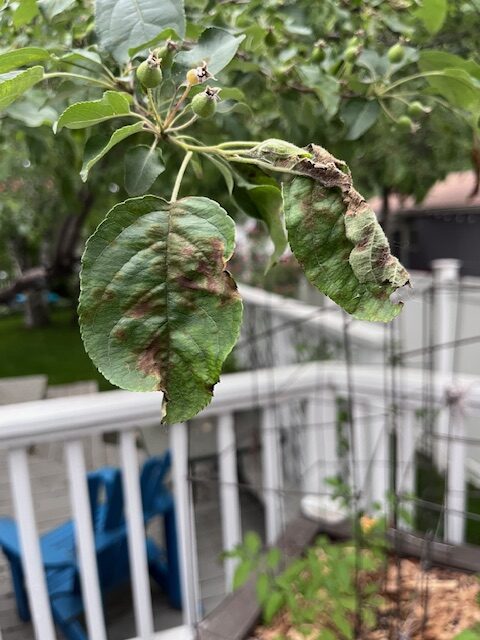Talking Plants
Jillian Patrie | University of Minnesota Yard and Garden Extension
Tree health has been a popular subject at the Clay County Extension Office recently. The consistent rainfall events have brought the return of leaf fungi and other wet weather plant issues. Let’s look at what area residents can be looking for, and whether what you are seeing is a concern or not.
Crabapple and fruit trees have been the target again this summer of wet weather leaf issues. Spots are appearing on leaves and depending on how summer rainfall trends proceed we may see the same issues we did last year. Apple scab is the most common issue affecting crab and apple trees during periods of wet weather. Leaves often have olive green to brown spots and scabs can cover the outside of growing fruit. In severe cases leaves will turn brown completely and drop early.
Leaf anthracnose is another common leaf issue when spring and early summer weather is wet. Usually, associated with cooler temperatures, symptoms of leaf anthracnose can persist through the growing season. Leaf anthracnose symptoms include tan or brown spots, cupped or curled young leaves; early leaf drop that is followed by a second leaf out.
Powdery and downy mildew will show up more frequently during wet or humid periods. Powdery mildew is found on the top side of leaves, more widespread and looks like fine dust. Downey mildew is found on both sides of leaves. On the bottom side it appears in dark brown angular patterns and on the top side it will appear as yellow angular spots.
Other fungi issues that are weather related are fire blight, needle cast (spruce) and late and early blight on vegetables. Managing fungi diseases can be done in several ways, starting with clean gardening practices. Pruning vegetables and landscape plants allows for more air movement through the canopy and watering at the base of plants not overhead can slow down the spread of fungi moved by water. Cleaning tools between pruning can prevent the spread of fire blight and other bacterial plant issues. Remove infected plant debris from growing spaces after trimming or in the fall this will reduce the chance of fungi overwintering and returning next season. Fungi disease symptoms like leaf spots cannot be fixed once they appear, however catching issues early and implementing preventative measures can help future outbreaks. In most cases treatment is not necessary, but some levels of infection can cause plant decline or death. Assessing the level of infection is done by determining the percentage of the canopy affected and if the amount will cause a decline in the plant’s overall health.
Labels on pesticides should be checked before application and the correct pest and/or disease has been identified. For more information on plant diseases visit https://extension.umn.edu/solve-problem/plant-diseases.
For questions about this article or local assistance, please contact Clay County Extension Educator, Jill Patrie at 218-299-7338 or by email at patri350@umn.edu.


